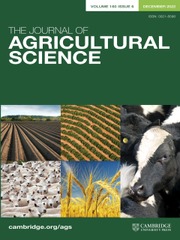Crossref Citations
This article has been cited by the following publications. This list is generated based on data provided by
Crossref.
Bulbule, A. V.
Talashilkar, S. C.
and
Savant, N. K.
1996.
Integrated rice straw–urea management for transplanted rice.
The Journal of Agricultural Science,
Vol. 127,
Issue. 1,
p.
49.
Eagle, Alison J.
Bird, Jeffrey A.
Horwath, William R.
Linquist, Bruce A.
Brouder, Sylvie M.
Hill, James E.
and
van Kessel, Chris
2000.
Rice Yield and Nitrogen Utilization Efficiency under Alternative Straw Management Practices.
Agronomy Journal,
Vol. 92,
Issue. 6,
p.
1096.
Timsina, J
and
Connor, D.J
2001.
Productivity and management of rice–wheat cropping systems: issues and challenges.
Field Crops Research,
Vol. 69,
Issue. 2,
p.
93.
Phongpan, S.
and
Mosier, A. R.
2003.
Effect of rice straw management on nitrogen balance and residual effect of urea-N in an annual lowland rice cropping sequence.
Biology and Fertility of Soils,
Vol. 37,
Issue. 2,
p.
102.
Takahashi, Shigeru
Uenosono, Shigeru
and
Ono, Shinichi
2003.
Short- and long-term effects of rice straw application on nitrogen uptake by crops and nitrogen mineralization under flooded and upland conditions.
Plant and Soil,
Vol. 251,
Issue. 2,
p.
291.
Dawe, D.
Dobermann, A.
Ladha, J.K.
Yadav, R.L.
Bao, Lin
Gupta, R.K.
Lal, P.
Panaullah, G.
Sariam, O.
Singh, Y.
Swarup, A.
and
Zhen, Q.-X.
2003.
Do organic amendments improve yield trends and profitability in intensive rice systems?.
Field Crops Research,
Vol. 83,
Issue. 2,
p.
191.
Cho, Young-Son
2005.
Effects of cover crop and straw mulching on no-tillage, no-fertilised, direct-sown rice cropping systems.
Australian Journal of Experimental Agriculture,
Vol. 45,
Issue. 10,
p.
1297.
Gangwar, K.S.
Singh, K.K.
Sharma, S.K.
and
Tomar, O.K.
2006.
Alternative tillage and crop residue management in wheat after rice in sandy loam soils of Indo-Gangetic plains.
Soil and Tillage Research,
Vol. 88,
Issue. 1-2,
p.
242.
Cucu, Maria Alexandra
Said-Pullicino, Daniel
Maurino, Valter
Bonifacio, Eleonora
Romani, Marco
and
Celi, Luisella
2014.
Influence of redox conditions and rice straw incorporation on nitrogen availability in fertilized paddy soils.
Biology and Fertility of Soils,
Vol. 50,
Issue. 5,
p.
755.
Zhao, Xinlin
Yuan, Guoyin
Wang, Huoyan
Lu, Dianjun
Chen, Xiaoqin
and
Zhou, Jianmin
2019.
Effects of Full Straw Incorporation on Soil Fertility and Crop Yield in Rice-Wheat Rotation for Silty Clay Loamy Cropland.
Agronomy,
Vol. 9,
Issue. 3,
p.
133.
Vashisht, B.B.
Jalota, S.K.
Ramteke, P.
Kaur, Ramandeep
and
Jayeswal, D.K.
2021.
Impact of rice (O. sativa L.) straw incorporation induced changes in soil physical and chemical properties on yield, water and nitrogen–balance and –use efficiency of wheat (T. aestivum L.) in rice–wheat cropping system: Field and simulation studies.
Agricultural Systems,
Vol. 194,
Issue. ,
p.
103279.
Longshang, Peace Raising
Singh, Virendra Pratap
Chandra, Subhash
Shukla, Anil
Singh, V. K.
Pareek, Navneet
Zhiipao, R. Rustum
Reddy, Kadapa Sreenivas
Duo, Hriipulou
Dorjee, Lham
and
Rayapati, Karthik
2024.
Optimization of nitrogen management reduce nitrogen stress and enhance productivity of super-seeder sown wheat under rice residue incorporation.
Discover Applied Sciences,
Vol. 6,
Issue. 4,

